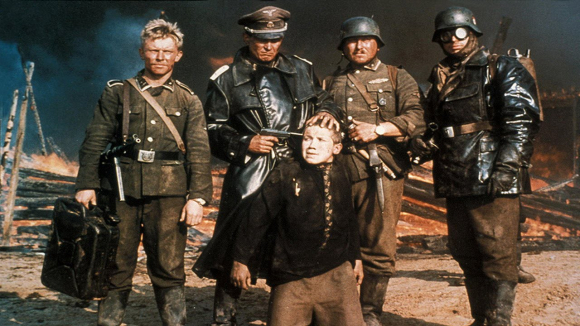Elem Klimov's communist parents constructed his first name as an acronym taken from Engels, Lenin, and Marx. During his 70 years, Elem Klimov made only five films: "Welcome, or No Trespassing" (1964), "The Adventures of a Dentist" (1965), "Agony" (1975) and "Farewell" (1981). "Come and See" was his astounding final picture that would finally establish Klimov as a storyteller of untold narrative depth and intuitive filmic sensitivity.
For the film, Klimov fashioned a detailed visual vernacular of dialectic form. His original, rigorous narrative format compresses the overwhelming heartbreak of Hitler's War. We experience its many jolts, shocks, and horrors. By the film's end, we witness a young boy's soul so terribly ravaged by the war's horrors that he resembles an old man.
Objectively, "Come and See" is Elem Klimov's brave attempt to cinematically compartmentalize and contextualize his own wartime experiences as a child escaping the battle of Stalingrad, in the company of his mother and younger brother, by raft across the Volga while the city burned to the ground behind them. Klimov said of the indelible event, in relation to "Come and See," "Had I included everything I knew, and shown the whole truth, even I could not have watched it."
Francois Truffaut’s third to last film, "The Lat Metro," draws on his childhood experiences growing up in Paris during the Nazi occupation between 1940 and 1944. Truffaut was born in 1932. Both his uncle and grandfather were active in the French Resistance.
For the most popular of his later films (“The Last Metro” won 10 César Awards), Truffaut spent years piecing together the script with details taken from newspaper stories or anecdotal experiences. The passive resistance of his characters exudes a confidence of purpose that they discreetly understate, and yet astutely pronounce with their clandestine actions, hidden in plain sight. That Truffaut wrote the film’s leading role of Marion specifically for Catherine Deneuve is transparent as it is rewarding.
Much like “Casablanca,” “The Last Metro” (1980) is a wartime romantic drama guided by the magnificent charisma of their similarly exquisite onscreen couplings. The ideal pairing of Gerard Depardieu (working at the height of his powers) with Catherine Deneuve is a cinematic treat every bit as enticing and fulfilling as seeing Humphrey Bogart and Ingrid Bergman fulfill their characters' ethical obligations. If Truffaut owes a great debt to “Casablanca,” he couldn’t have paid it back with any more style, integrity, wit, authenticity, and nostalgic romance as he creates with "The Last Metro."
Rainer Werner Fassbinder’s bold depiction of postwar Germany in “The Marriage of Maria Braun” shares a theme of womanly independence to that of Barbara Stanwyck’s implacable character in the pre-code classic “Baby Face” (Alfred E. Green, 1933). Guided by his frequent muse Hanna Schygulla (“The Bitter Tears of Petra von Kant”), Fassbinder takes a dryly neo-realist approach that combines documentary techniques with formal compositions to underpin the drama. Michael Ballhaus’s brilliant cinematography is two parts raw and refined.
As Maria partners with a wealthy industrialist, to whom she also serves as his mistress, she accumulates the wealth she seeks to provide for her Nazi soldier husband upon his release from prison. The war has transmogrifies her heart into a ball of repressed emotion. Maria and her husband are victims of a war whose effects will continue to be passed for many generations to come. The economics of war is always a lose/lose proposition; regardless of how much money it drives.
It has taken decades for the shocks of controversy surrounding Liliana Cavani’s magnificent picture “The Night Porter” (1974) to catch up with the uncomfortable intimate truths that Cavani illuminates. Liliana Cavani was 40 years ahead of her time.
If the plot sounds like a pure sexploitation picture along the lines of “Ilsa, She Wolf of the SS,” it proves every bit as transgressive, but all the more political in its provocations.
Charlotte Rampling is Lucia, a leftist (non-Jewish) Holocaust survivor who carried on a BDSM relationship with one of her Nazi guards during her time spent starving in the concentration camps. Lucia played the part of a submissive who received protection in return from her SS dom lover Max (Dirk Bogard).
It is 1957 when Lucia, now married to an American orchestra conductor, discovers her former SS master working as a night porter in the Vienna hotel where she and her husband stay. Soon the former lovers are up to their old games of master-and-slave.
Cavani doesn’t merely flirt with the taboo subject matter of a prisoner and guard carrying out their roles within the context of obsessive fetishized sex, she grabs it by the throat and listens to the body gasping for air. Sex allows Max and Lucia to breathe.
People will always find ways to express themselves regardless of the physical or mental restraints placed on them. If those expressions take on an intrinsically dark and primal reflection then you know you have hit the animal nerve that sex brings out in all of us. Freedom is a construct of the mind that allows the body to follow down any hallway, no matter how dark.
A small request: Help keep Cole Smithey writing reviews, creating video essays, and making podcasts. Click on the button to pledge your support through Patreon, and receive special rewards!









